You’re in Japan, in a restaurant, and two items jump out at you: sushi and sashimi. You know sushi contains fish, but you don’t know what sushi is vs sashimi. The waitress is with other customers, and you can’t work out if sushi is the same thing as sashimi. So, you pull out your phone and do a quick search, and type in “What is sushi vs sashimi?”
You’re in the right place. In this article, we’ll explore what sushi is vs sashimi, and the different types of sushi you can buy. By the time you’re finished, you can order your meal confidently and be sure you’re getting what you want to eat.
What is sushi vs sashimi?: Main Difference
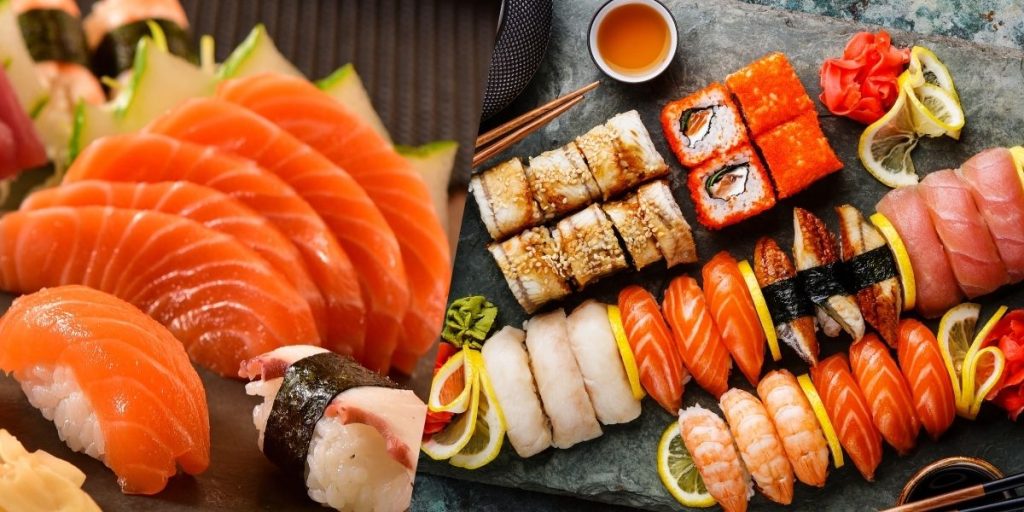
The answer to your question “What is sushi vs sashimi?” is simple: rice.
Sushi is prepared using vinegar-soaked rice, and sometimes vegetables. Sashimi, on the other hand, has no rice: it is merely thinly sliced seafood, usually tuna or salmon. This will, of course, affect the flavor and texture of the fish.
Let’s take a closer look at what sushi is vs sashimi to better understand what you will get if you order either of the two.
What is sashimi?
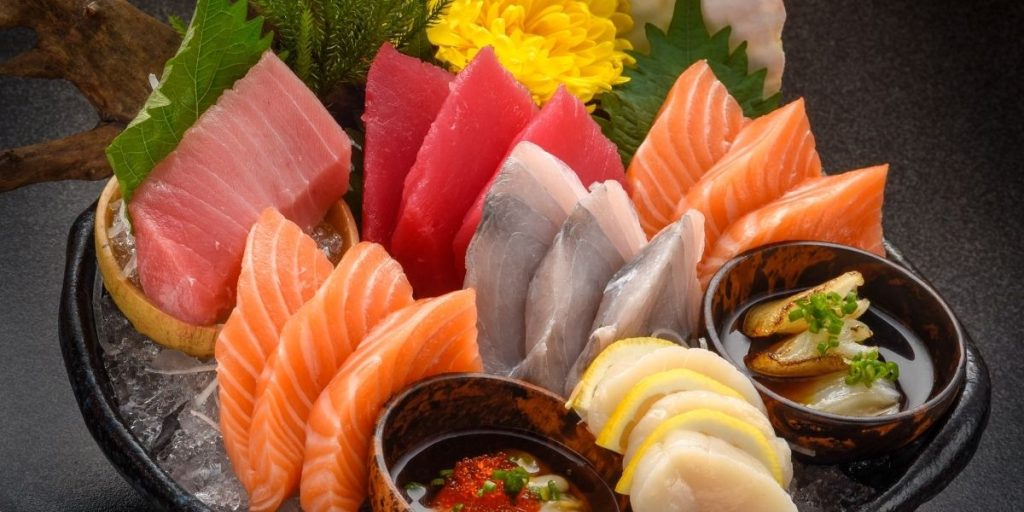
Sashimi is not sushi. In fact, the name translates to “pierced body”: this refers to the delicate manner in which the fish is prepared and served. Sashimi is served plain and is sometimes accompanied by soy sauce. This ensures the fish is the star of the dish and doesn’t get melded with other flavors. The soy sauce helps the fish to shine, as it brings out the natural flavor of the fish.
Sashimi is prized in Japan and is made using the highest-quality seafood. Everyone from the fisherman to the chef plays a part in the quality of the sashimi. For starters, the fish used to make sashimi isn’t caught with other fish in a net. It is caught on a single line and is placed on ice immediately after being reeled in. This ensures the fish is as fresh as possible and decreases the amount of lactic acid that builds up. Lactic acid is a waste product that is produced as a fish flails vigorously on the line- it decreases the quality of the fish and its health benefits.
Some of the most popular fish used to make sashimi include fatty tuna, yellow tail or squid. These fish are caught in saltwater because they contain fewer parasites than freshwater fish.
After being prepared, it may be served atop other meats such as chicken or beef, or laid on a bed of daikon, or white radish. Sashimi is no longer considered sashimi if it is served with rice.
Sashimi is high in omega-3 fatty acids and proteins, and is a relatively low-carb appetizer or meal.
What is sushi?
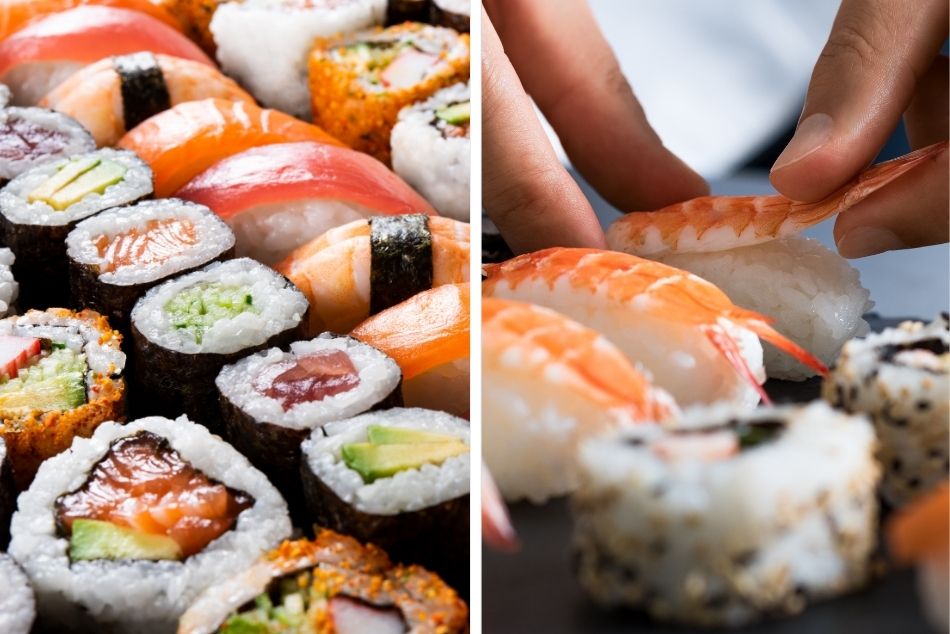
The word sushi translates to sour rice. This is fitting, since the short-grained rice used is soaked in rice wine vinegar to add flavor. This makes the rice sticky and allows for other ingredients to be clumped together in a single unit. The sticky rice is usually paired with seafood.
Unlike sashimi which describes only raw fish, sushi can include either raw or cooked ingredients such as prawns, tofu, avocado, eggs or cucumbers. It is also higher in carbs due to the rice but generally contains similar health benefits to sashimi.
Sushi types: nigiri / maki / temaki / gunkan
Now here’s where it gets even more complicated. You might have thought “What is sushi vs sashimi?” was the hardest question you had to answer, but there are different types of sushi.
Nigiri
Nigiri contains sashimi. Confusing isn’t it?
The word nigiri 握りmeans grip or handle. It’s a rectangular mound of rice (about two fingers size) that is topped with sashimi.
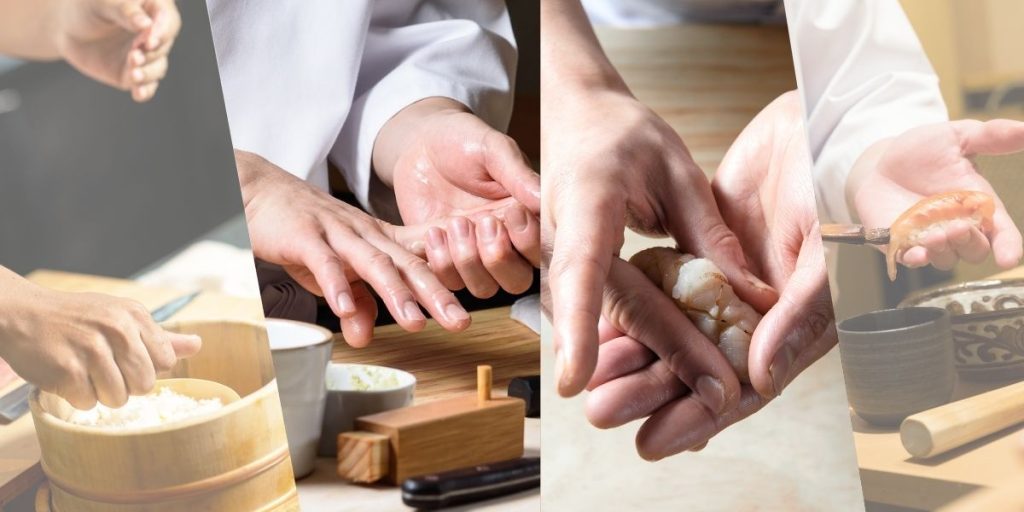
The rice used to make nigiri is different from your usual sushi since the rice is only dipped in vinegar, and not allowed to soak.
Between the rice and the sashimi lies a piece of wasabi that acts as glue for the sashimi and the rice. This adds a little spice to the nigiri, and it may be all tied together with a piece of seaweed.
Some of the most popular types of nigiri are sake 鮭 (salmon), toro (fatty tuna), unagi (eel) and ebi 海老 (shrimp). They’re usually served in pairs and sometimes come as a platter.
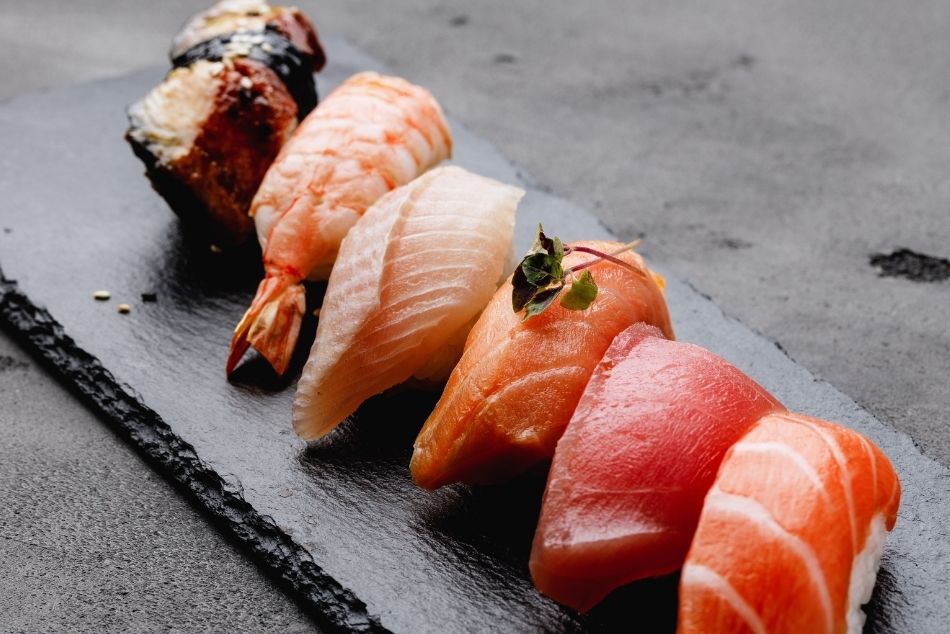
Maki
Maki 巻き is arguably the most common type of sushi. It is rolled in seaweed then sliced into bite-sized pieces.
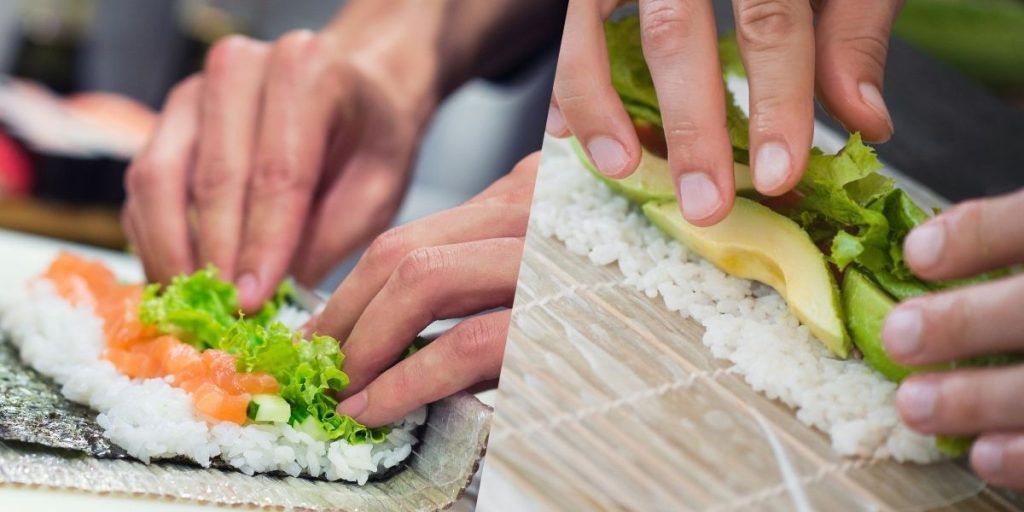
A roll is usually cut into six or eight pieces and each piece contains equal amounts of varying ingredients. Maki is categorized according to its size, namely hosomaki (small), nakamaki (medium) and futomaki (large).
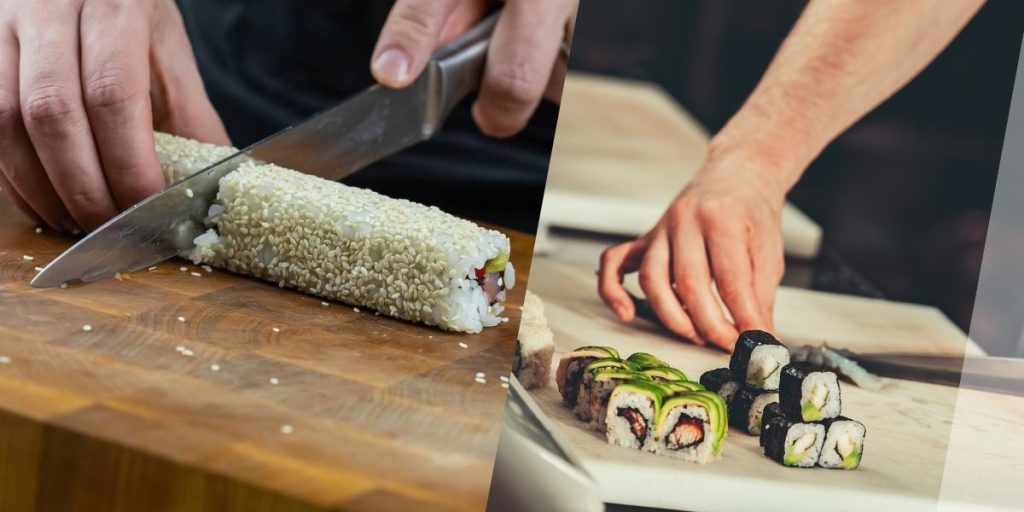
Famous examples of maki include kanpyo maki (dried gourd strips sushi roll), kappa maki (cucumber sushi roll), shinko maki (pickled radish sushi roll), natto maki (fermented soybean sushi roll), tekka maki (raw tuna sushi roll) and ehomaki (恵方巻, sushi roll that brings good luck).
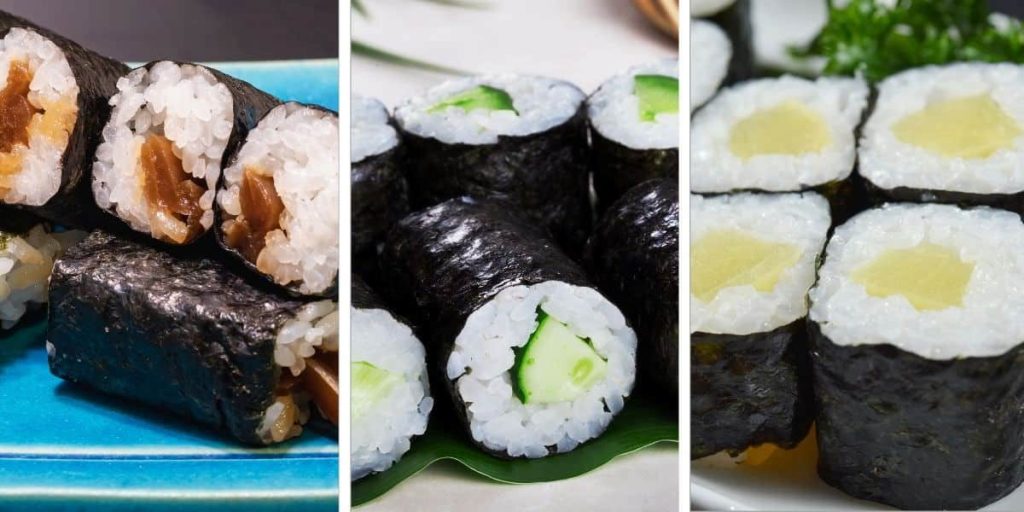
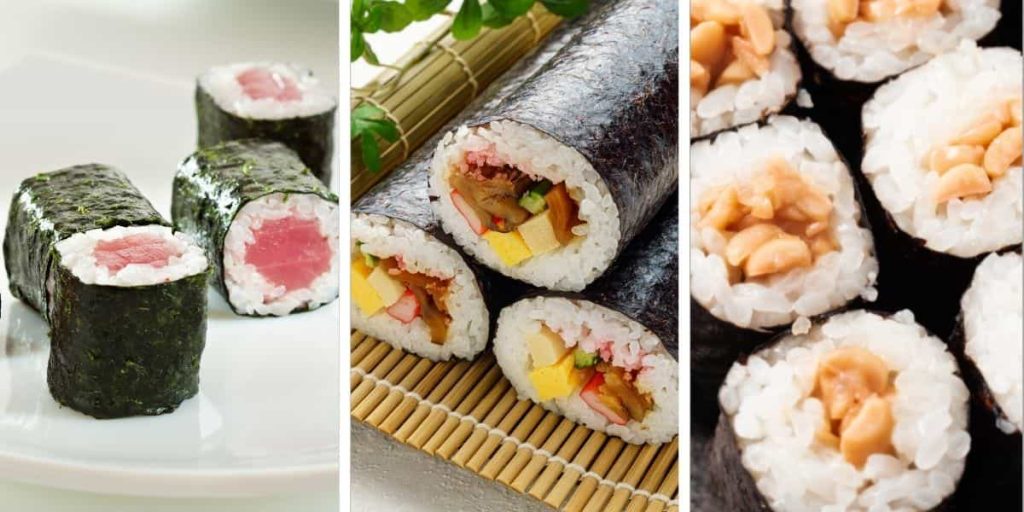
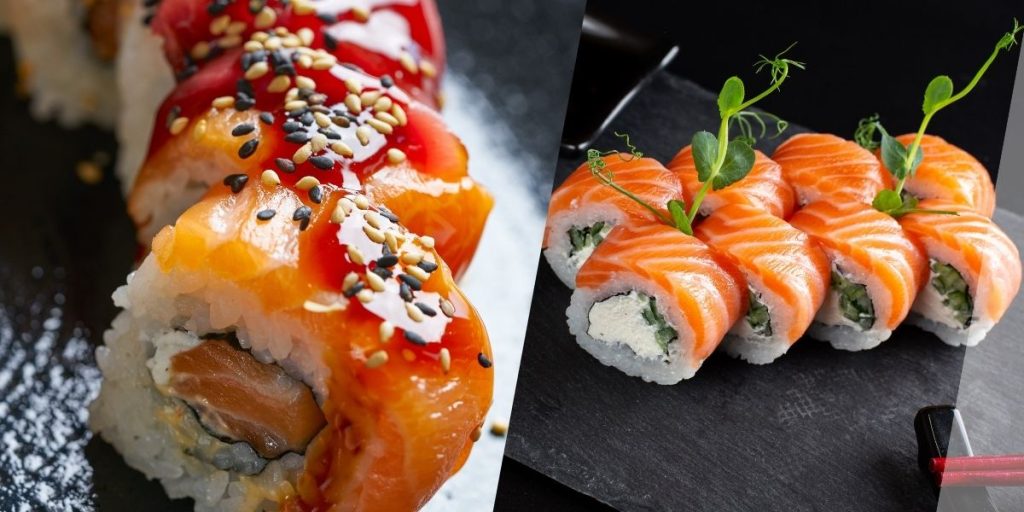
Temaki
Temaki 手巻き is similar to maki, however, instead of being rolled with a bamboo mat, it is rolled by hand. This means that it is larger in size and takes the shape of a cone. Also unlike maki, it is a single-person meal, and isn’t sliced like maki.
Some popular types of temaki include fried shrimp temaki, pork kimchi temaki, omelet rice temaki, hainanese chicken rice temaki, and roast beef and salmon temaki.
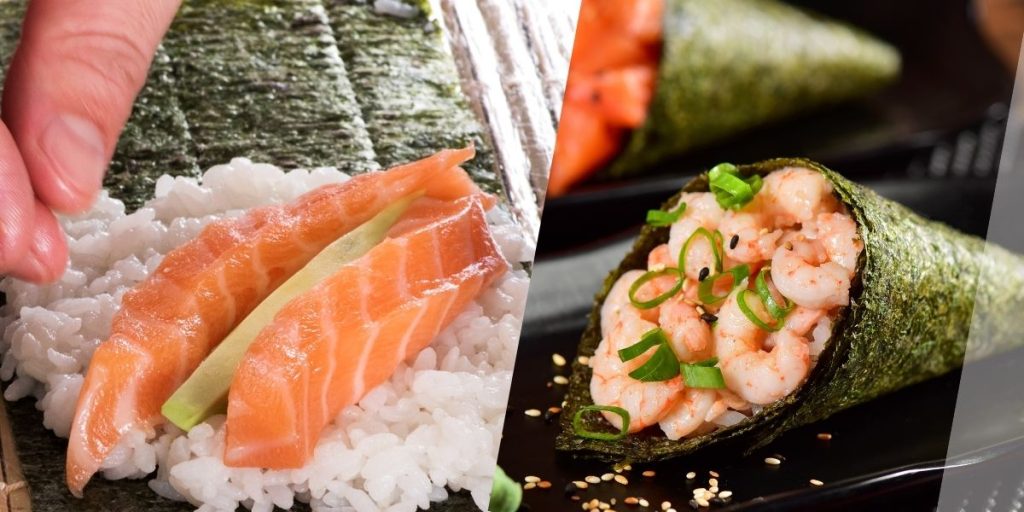
Gunkan
Gunkan or gunkanmaki is not a wrapped type of sushi. Instead, it uses small, dried seaweed cups that are stuffed with seafood. The name gunkan 軍艦 means battleship in English; indeed, many have likened this style of sushi to a little ship. Gunkan is often served with roe, or ‘liquid sushi’ on top.
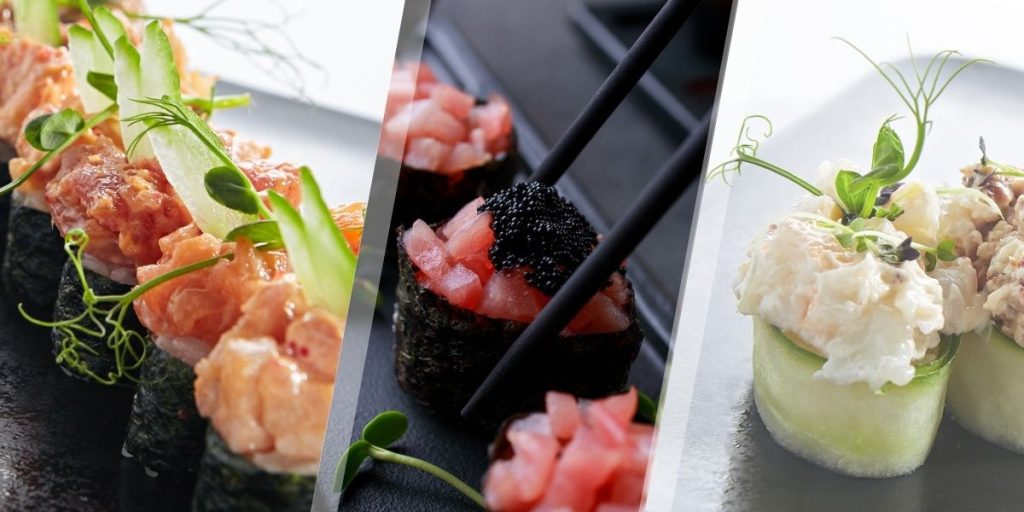
Japanese Table Manners
On the other side of the world, table manners are different from back home. Besides knowing what sushi is vs sashimi, you are expected to conduct yourself according to Japanese standards .
Here’s what you need to know:
If possible, make a reservation, and arrive on time.
Your chef or host is likely to shout “Irasshaimase” as you walk in. This means “Welcome” in Japanese honorific form.
When seated, do not ask if the fish is fresh. This is impolite.
If the restaurant appears dirty or unsanitary, simply leave.
When you are seated, you will be presented with a hot, wet towel called an oshibori. Use it to clean your hands, then hand it back to your waitress folded.
Start your meal by saying “Itadaki-masu” which means “Thank you, I humbly receive (this meal)”.
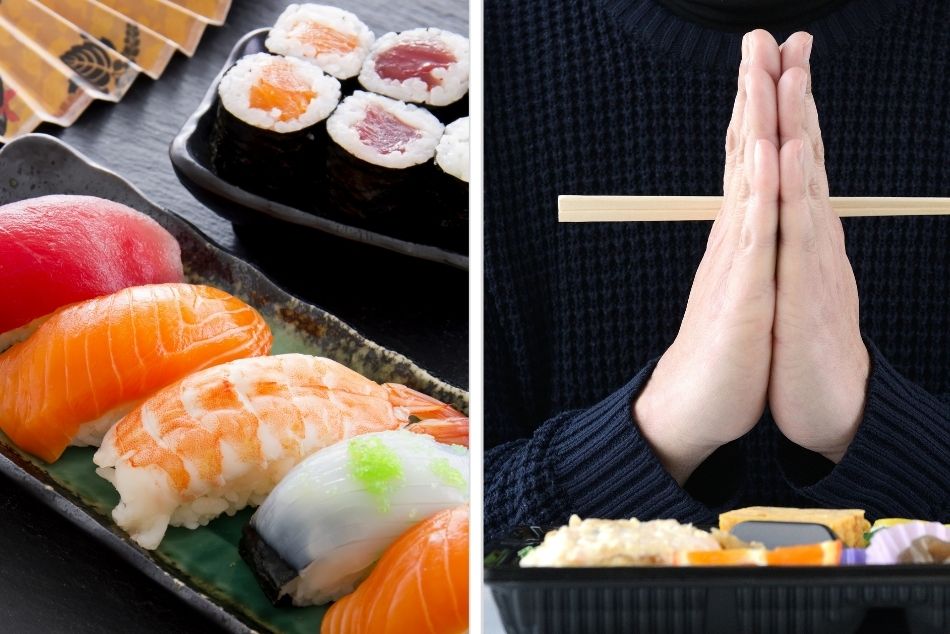
Chopstick etiquette
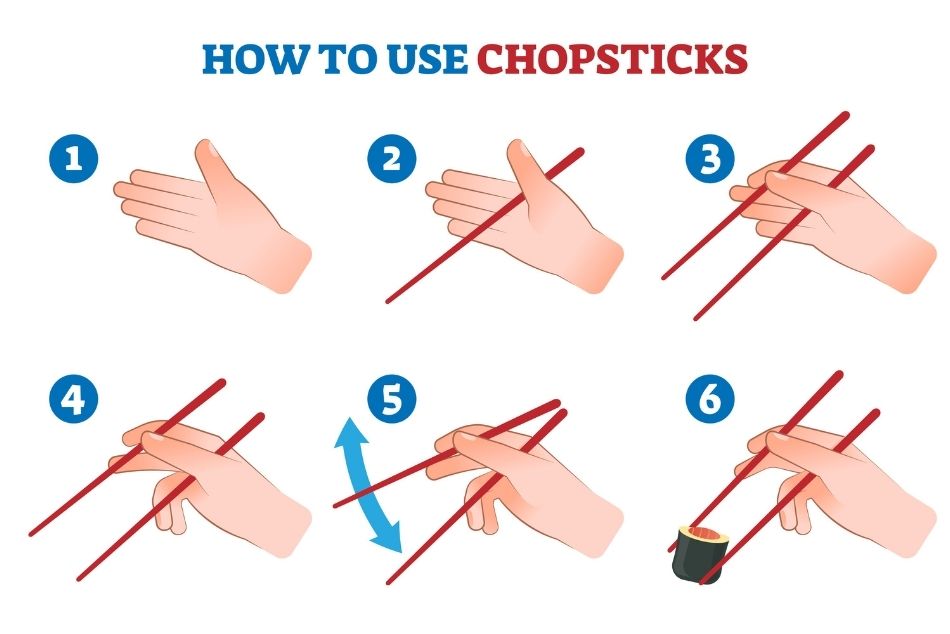
You are expected to eat sushi with your hands or with chopsticks, and sashimi with chopsticks only. You probably won’t even find a fork around to help you.
When using your chopsticks, avoid rubbing them together. In Japan, this is how the quality of the chopsticks are tested and you might give your host the impression that you think the chopsticks are cheap.
Do not use your chopsticks to point at someone when talking, or to point at dishes you find appetizing. Do not wave your chopsticks around, or suck sauces off your chopsticks.
You should also avoid picking up sushi from another person’s chopsticks with your chopsticks. This is similar to a Japanese cremation tradition where the bones of the deceased are passed from one person to another.
Also, you should never leave your chopsticks sticking up. This is symbolic of incense, which is used by Japanese people at funerals, or when showing respect to their ancestors.
Eating sushi in a high-end Japanese restaurant
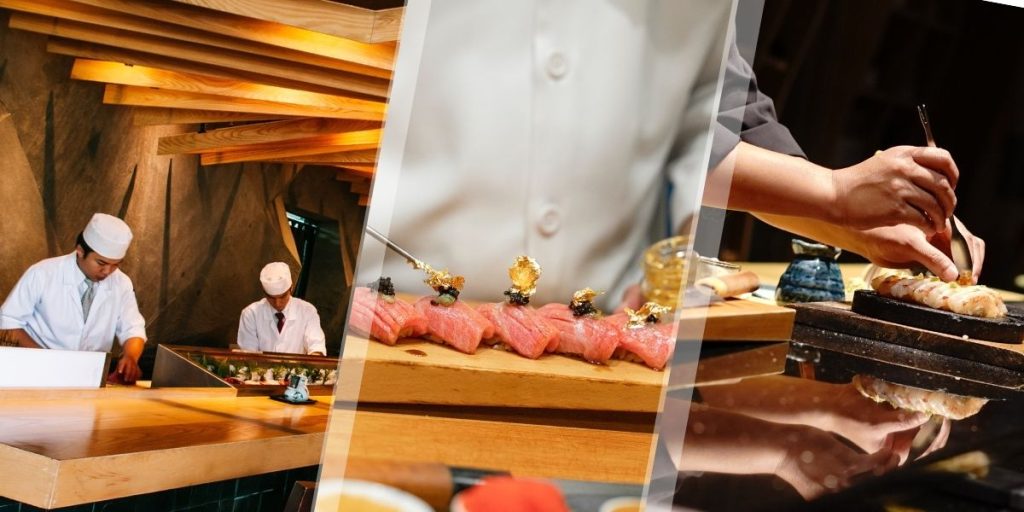
When in a high-end Japanese restaurant, or omakase, you’re expected to eat with your hands. Do not add wasabi or dip your sushi in soy sauce unless your chef recommends it. The chef knows what he/she is talking about, and anyway, you wouldn’t want to overpower the flavor of the sushi with condiments. If your chef suggests the toppings, you must be careful.
How to eat sushi in a revolving sushi bar
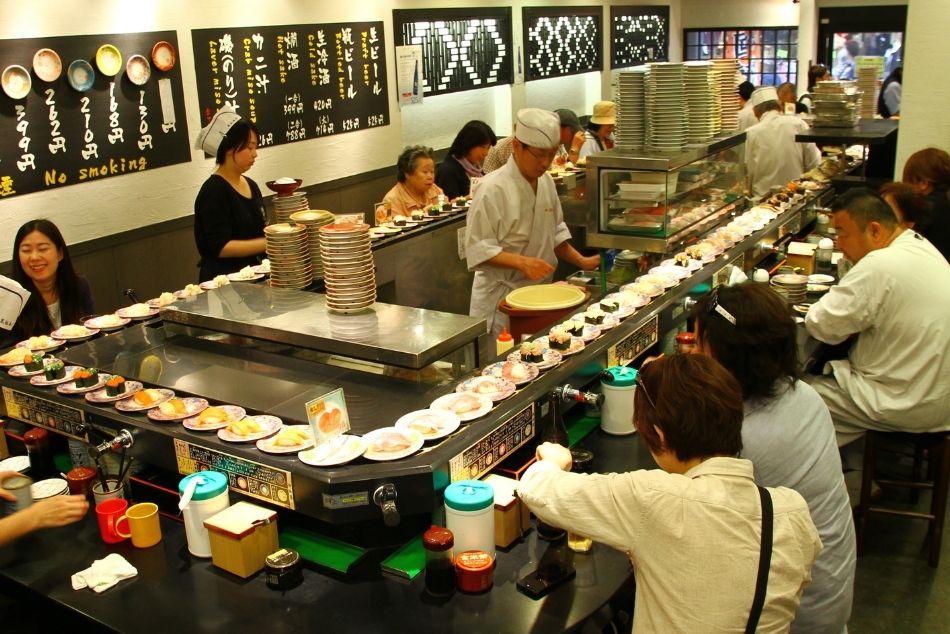
If you are in a revolving sushi bar, you’ll notice that the sushi will come in a specific order. Otherwise, start with the whiter, lighter fish then proceed to the richer, oilier types of seafood.
Use your chopsticks to pick up the sushi. You are free to dip it in the soy sauce as you please. Though the sushi is tightly wrapped, the rice can fall apart if you dip it incorrectly. Instead, mix the wasabi into the soy sauce, then dip only the fish side of the sushi into the soy sauce. Be careful not to add too much wasabi, since this can end up ruining your meal.
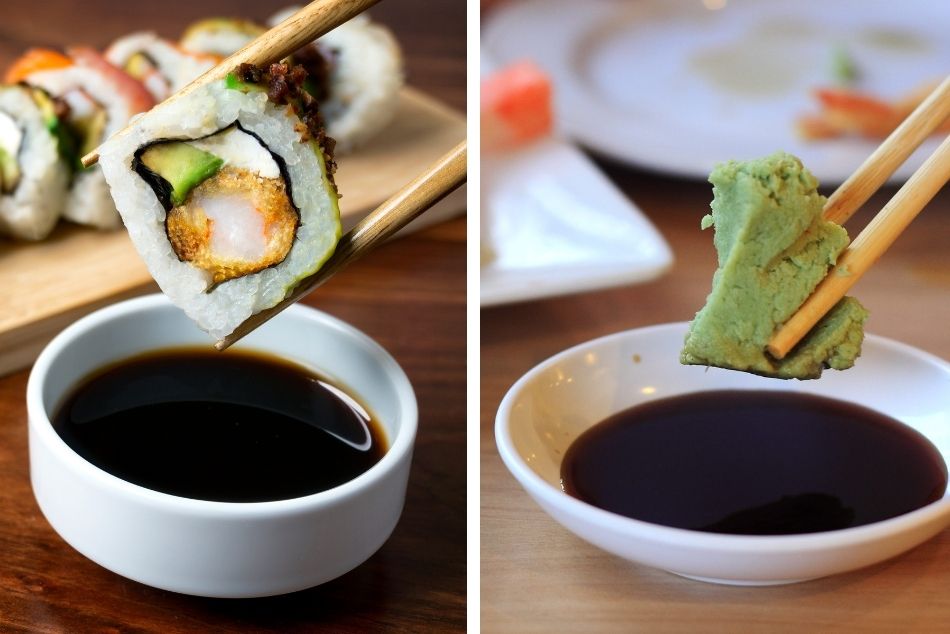
If available, use the pickled ginger to cleanse your palate– do not add it to your sushi. You might also want to take a sip of green tea between the different types of sushi so you can taste each one properly.
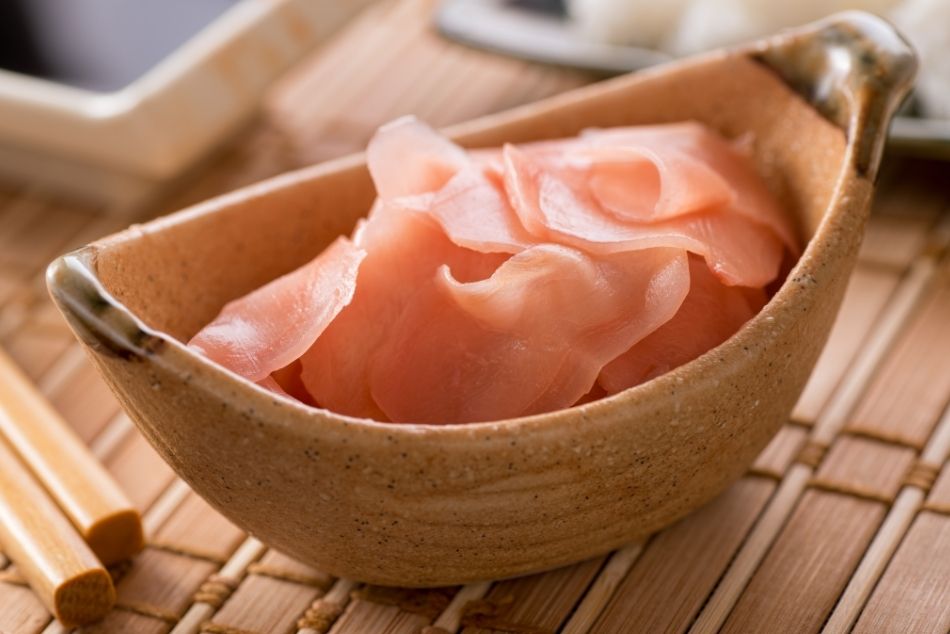
When drinking alcoholic beverages, it is customary to pour the drink for the person beside you instead of yourself. Pay close attention to his/her cup and refill as needed. Usually, the most “important” or “prestigious” person does the pouring. This will depend on age or status, so your father or manager would pour your drink.
Do not belch, since this is impolite. When it’s time to make a toast or cheers, say “Kanpai!”
Before leaving
When dining in a high-end Japanese restaurant or omakase お任せ (leave a decision to someone else), the chef will control the order of your meal. Be sure to finish every bite as leaving any pieces behind is considered rude and wasteful.
You might want to share your delicious sushi with friends, but do not ask for sushi to go. Sushi is best enjoyed fresh, and the chef might think this is your way of getting out of eating it.
Do not linger at the sushi bar or omakase after finishing your meal. While you may be used to chatting with friends after your meal back home, in Japan, it’s considered rude, especially if the restaurant is busy.
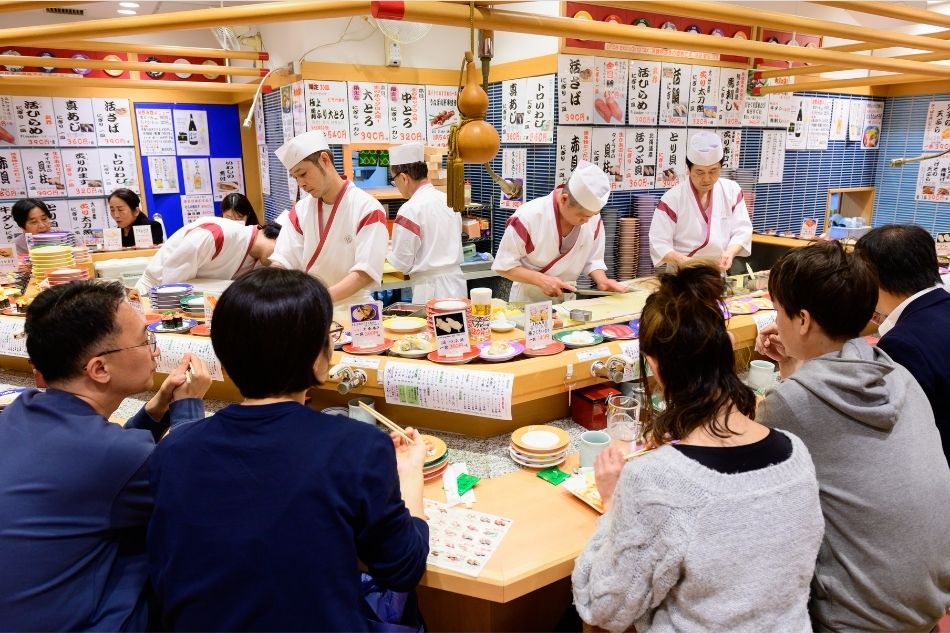
And don’t tip. This is not customary in Japanese culture.
Express your gratitude by saying “Domo arigatogozaimasu” which means “Thank you very much” in Japanese, or “Oishii” which means “Delicious” in Japanese.
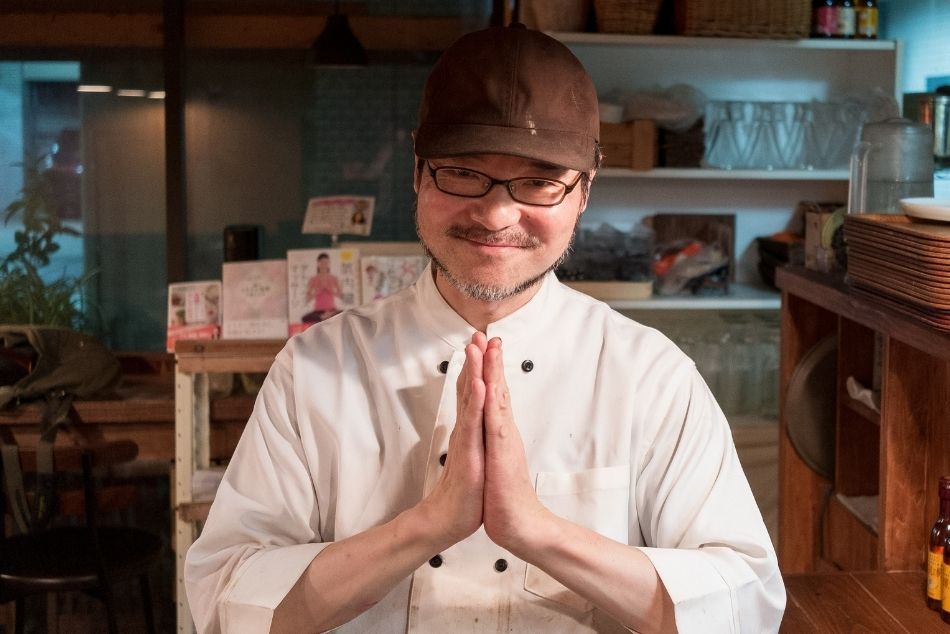
Conclusion
Now that “What is sushi vs sashimi?” is out of the way and you’ve mastered Japanese table manners, you can go out and enjoy all the sushi and sashimi you like! Just remember to show gratitude to your host and chef before you leave!

conta aberta na binance
Sunday 14th of December 2025
I don't think the title of your article matches the content lol. Just kidding, mainly because I had some doubts after reading the article. https://accounts.binance.info/id/register-person?ref=UM6SMJM3
Kisisel Hesap Olusturun
Friday 5th of December 2025
I don't think the title of your article matches the content lol. Just kidding, mainly because I had some doubts after reading the article. https://accounts.binance.com/zh-CN/register-person?ref=WFZUU6SI
Открыть счет на binance
Sunday 30th of November 2025
Thanks for sharing. I read many of your blog posts, cool, your blog is very good.
ai generator
Thursday 27th of November 2025
That’s a fascinating take on predicting outcomes! Seeing tools like AI Agent streamline content creation is wild – imagine the data analysis possibilities for handicapping! It’s a game changer.
binance код
Tuesday 18th of November 2025
Your point of view caught my eye and was very interesting. Thanks. I have a question for you.